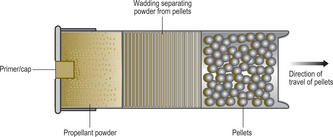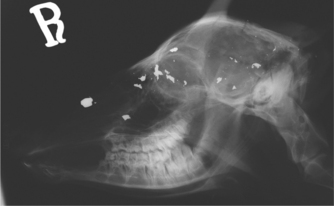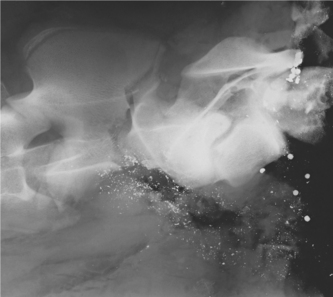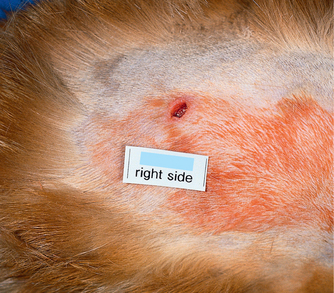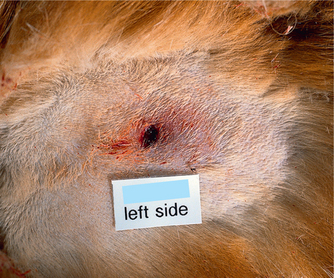8 Firearms Injuries
Types of weapon
Shotgun
These weapons are single or double barrelled. The barrels are smooth-bored and the shotgun discharges multiple pellets in a mass each time it is fired. There is a variety of barrel lengths and calibres,1 the calibre of the barrel usually being referred to as the ‘bore’ or ‘gauge’. The 12-bore (0.729 inches/18.2 mm) is probably the most commonly used shotgun. An exception to the classification of ‘bore’ size is the ‘410’, which refers to the actual diameter of the barrel (0.410 inches) and is the smallest of the commonly encountered shotguns.
Rifles
There are many calibres of rifle. Common hunting rifle calibres include .22, .243 and .270 (range 5.7–7 mm).2 Rifles are further categorised by the method of ignition of the explosive charge in the cartridge. Those in which the firing pin strikes the rim of the cartridge are known as ‘rimfire’, whereas those that strike a central primer in the cartridge are called ‘centrefire’ rifles.
Ammunition
Air-rifle pellets
The pellets used in air-guns and air-rifles are the same, and are usually constructed of soft lead. The diabolo type of pellet has a narrow waist and a rounded point. Other lead pellets have straight sides and a more conical point. In the ‘Prometheus’, a polished zinc head is enveloped in a flexible synthetic jacket. This pellet is reputed to be capable of penetrating steel and so may be potentially more dangerous in head injuries.3 The ‘Sabo’ pellet is also of compound construction, having lead and plastic components. Fragmentation of these two types of pellet can result in separation of the radio-opaque head of the pellet from the radio-lucent nylon or plastic part that remains within the wound track.
‘BB’ ammunition for air-guns is spherical lead shot that derives its name from the original method of describing the size of the lead balls. In this case, the shot size was between ‘B’ and ‘BBB’.
Shotgun cartridges
The cartridge (Fig. 8.1) consists of several parts:
Examination of a suspected firearms injury case
Radiography
Radiographs can aid in establishing, early in the investigation, which type of weapon was used (shotgun, rifle or air-rifle). Fragmentation patterns, as seen in radiographs, can be helpful in identifying the type of ammunition. For example, on striking dense bone, low-velocity .22 bullets break into a variable number of large and small radio-opaque fragments (Fig. 8.3). The greater energy associated with high-velocity bullets causes these bullets to disintegrate to a greater extent and may result in the fragmentation pattern commonly known as a ‘lead snowstorm’ (Fig. 8.4).
Firearm wounds
General
In most cases the entry holes, and to a lesser extent the exit holes, will be obscured by hair or feathers. Clipping the hair or careful plucking of the feathers is necessary to reveal the skin wounds (Figs 8.5 & 8.6). Clipping the entire side of an animal will give a clear indication of the scatter of shotgun pellet injury (Fig. 8.7). Depending on the stance, position or action of the victim (e.g. flying, running, stretching, jumping), the skin wounds may or may not lie directly over deeper injuries found at post-mortem examination. Initial observations should include a description of surrounding bruising and the size and shape of hole. Frequently, feathers or tufts of hair are drawn into an entry hole and provide convincing evidence that penetration occurred at these sites. Usually these hairs or feathers are found in the skin or subcutaneous tissues, but on occasion they may penetrate more deeply to the body cavities and the internal organs (Fig. 8.8).
Stay updated, free articles. Join our Telegram channel

Full access? Get Clinical Tree


